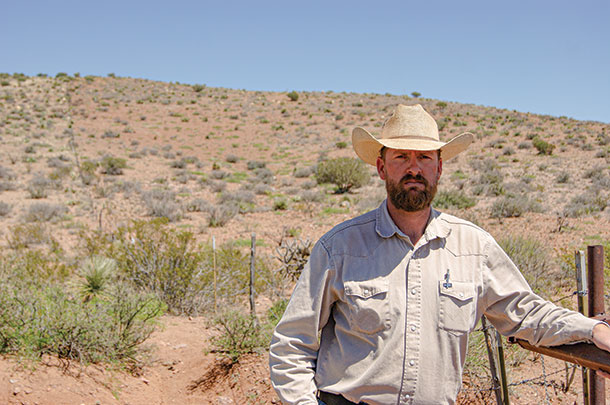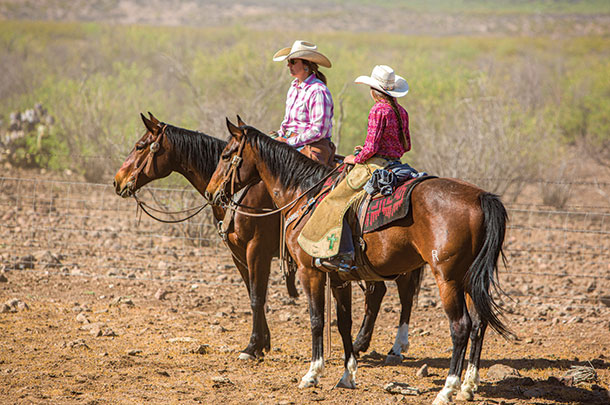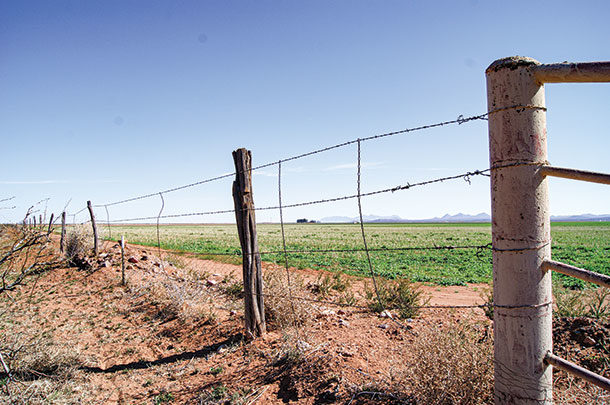Overrun with illegal immigrants, New Mexico ranchers are hoping their voices are not ignored as the debate regarding border security gets louder and louder. For years, New Mexican ranchers have seen illegal activity on the border, ranging from men coming for work in the U.S. to cartel traffickers dropping marijuana bales on their property.
While illegal immigration has always been a part of New Mexico history, the current traffic across the border has left ranchers in the area on edge. Currently, the El Paso sector of the U.S. Border Patrol has apprehended approximately 70,000 persons during the fiscal year; at this time last year, they had apprehended roughly 11,000.

“My family has seen all facets of traffic across the border,” says Russ Johnson of Johnson Ranches in Deming, New Mexico. With roughly 8 miles of their ranch on the border, the Johnson family’s sizable cow-calf operation has been in the middle of the fight for border security since 1918. A fourth-generation New Mexican rancher, Russ, along with his wife, Brandy, returned to the family ranch in 2006 right in the height of a new wave of illegal immigration.
In 2005 and 2006, the Border Patrol’s El Paso sector identified the Johnson ranch as sitting in a weak point along the border. New Mexico Gov. Bill Richardson declared a state of emergency due to the high number of illegal crossings, estimated upward of 1,000 people crossing over each day onto the Johnsons’ private pastures in an attempt to come north.
As a result, the Johnson Ranch was part of the Secure Fence Act passed by the Bush administration, and in 2008 they had 5 miles of Normandy-style vehicle barriers placed along their fences.
However, Brandy still finds herself watching Border Patrol chase illegal immigrants down the highway in front of their house on almost a daily basis. Helicopters flying over their home at all hours are common, and finding cut fences or destroyed barriers are just a daily part of ranching.
“We don’t want our cattle going into Mexico or Mexican cattle coming onto our ranch,” says Johnson. “So we fix it (fences and barriers) at our own expense and safety.”
Though the Johnsons did see some reprieve after the new barriers were constructed in 2008, the problem simply moved elsewhere. “Traffic ebbs and flows,” says Russ. “It isn’t because it’s less; it’s because they have just found another place to cross.”
Predicting patterns
Because traffic moves from different areas on the border, Border Patrol plays a game of cat and mouse with illegal smugglers; in past years, Border Patrol has been fairly successful in predicting migration patterns based on work and drug activity. However, according to Border Patrol Special Operations Supervisor Ramiro Cordero, the current crisis being faced on the border is unlike anything seen before.
In recent years, New Mexico and other border states have seen an influx of immigrants that has left agents feeling ragged. In the past, illegal immigration on the southern border has consisted mainly of adult males from Mexico, which were easy for Border Patrol to manage due to a streamlined system consisting of apprehending, processing and then releasing the fugitives back to that country. More recently, Border Patrol has seen an increase of immigrants traveling as families with children from Central American countries.
“Never did we predict a wave like this,” says Cordero. A 19-year veteran of the Border Patrol, Cordero has always seen various types of immigrants trying to make their way north. Despite all the training and expertise that Border Patrol has, Cordero noted that this wave of immigrants from Central America has backlogged the efficient system used for Mexican nationals.
“Most of the activity is concentrated to the El Paso metropolitan area; however, the fact that we are having to redeploy agents to processing and transporting duties makes rural areas vulnerable to criminal activity,” states Cordero.
Couy Griffin, chairman of the Otero County Commissioners, knows his county is being crushed under the influx of illegal immigrants coming into the El Paso area. “We border El Paso to the south, and we’re seeing narcotics escalate like never before,” says Griffin. While Otero County may be one of the first stop-offs for the cartels, Griffin believes this is more of a national issue than it is a state issue. “The drugs coming through our county are being shuttled into the rest of the United States,” he says.
Though Border Patrol is seeing illegal traffic impacting rural areas in New Mexico, the Bureau of Land Management in New Mexico has not had any recent issues or reports on public lands within the El Paso sector. With many ranches in border counties being BLM permit holders, the areas Cordero states as being at risk are often federal lands. However, in an official statement, the BLM office in the Las Cruces district said, “While some permittees have noticed an increase in illegal border crossings on their public land allotments, they have not reported any impacts to their federal grazing operations on public land.”
Wary of the door visits
Roughly 80 miles from the Johnsons in Deming, the Valdez family of the JO Bar Ranch are feeling the pressure of these caravans from Central America. Erica Valdez, a third-generation rancher, feels like she is trying to make a living in the middle of a national crisis the rest of the country can’t quite wrap its mind around.

News coverage regarding the border may be more prevalent, but locals feel that unless you’re there, it’s hard to even imagine the daily occurrences. Whether it’s gang members or illegal travelers in need of water, knocks on the door have become something ranch wives and mothers have begun to dread. “I’m so wary anymore that I don’t open the door unless my husband is home,” Erica says.
With easy access to the interstate right off the JO Bar Ranch, the ranch has been a central location for drug cartel traffic. Since 2004, Valdez states that they have seen a more dangerous type of traffic coming across their ranch. Fifty-pound bales of marijuana left for pick-up, camouflage clothing and evidence of heavy machinery have been regular finds in pastures on the ranch.
Though her family hasn’t had any dangerous encounters recently, Valdez notes that she often has people coming to her door because they are lost, hungry and deserted by their smuggler. “My heart breaks for them,” she says. With ranchers often being the first to lend a helping hand, the current turmoil on New Mexico’s border has left many feeling at risk when it comes to handling people in need. Due to the remote nature of these operations, Border Patrol often serves as the first responders in such situations. “We are often the closest thing the ranches have as far as law enforcement,” states Cordero.
Raised on the family ranch in Animas, New Mexico, Valdez now finds it challenging to raise her own daughter in the midst of such dangerous circumstances. With the kidnapping of a local man just three years ago, the Animas ranching community still finds itself looking over their shoulders when gathering cattle and doing day-to-day work. “We never had to have these conversations when I was a kid,” she says. “It’s not just about getting the cows in off a section anymore.”
Though Valdez does agree there is a new influx of traffic from Central American countries, she does not believe that dangerous, drug-related trafficking has subsided. “The cartel is taking advantage of that distraction (caravans of people turning themselves in at the border),” she says. “We’re fortunate enough to have a president that recognizes that.”
Responding to a crisis
Much like the Johnsons in Deming, Murray and Judy Keeler have seen all the changes in immigration since purchasing their ranches in 1979. Not far from Valdez and the JO Bar, the Keeler ranches in both Hachita and Animas see their fair share of illegal activity. “We have a governor in New Mexico who doesn’t think we have a problem,” says Judy, “but it’s a crisis.”
“The immediate effect (of illegal immigration) is felt on the state level,” says Valdez. “Unfortunately, our state government refuses to recognize that. They call it a ‘humanitarian issue.’”
When asked for an official statement regarding the issue, Tripp Stelnicki, director of communications for Gov. Michelle Lujan Grisham, said “[The governor] feels there is absolutely a humanitarian crisis, one that requires a coordinated effort to address for the sake of New Mexico residents as well as the asylum-seeking migrant families and individuals.”
As the impacts of illegal immigration are heavily concentrated in rural New Mexico counties, elected officials such as Griffin say they want to use power to protect constituents. “Our governor continues to stand on her statement that there is no crisis,” states Griffin, “but we [county level officials] stand on the power granted to us by the U.S. Constitution.” In Otero County, Griffin plans to pass a resolution by May 2019 that blocks the state government from housing illegal migrants in the county.
With New Mexico’s flat landscape being conducive to human trafficking, the lack of shelter and water often leave immigrants seeking aid on ranches. In the wake of women’s movements across the country, Judy Keeler believes this crisis in New Mexico should also be acknowledged as important. “I think this is a woman’s issue on these ranches,” she says, stating that it is often the women living on the border who are most often at home with children when people are seeking aid at their homes. Judy, like Valdez, has encountered plenty of harmless individuals at her doorstep. But run-ins with more dangerous individuals who demand aid have left her feeling weary.
Concerned from a political standpoint about how many people the U.S. can absorb from these other countries, the Keelers are also on edge regarding the risk ranchers on the New Mexico border face with the potential spread of disease (from unvaccinated immigrants) to their cattle. Both Russ Johnson and Valdez concur with this concern, noting that often immigrants will find their cattle water sources, which can lead to both the contamination of water and broken floats which drain the already limited supply of water. Though there are not many common cases of zoonotic disease being transmitted from humans to cattle, diseases such as tuberculosis can be transmitted through direct contact.
Despite being overwhelmed by the recent changes in migration demographics, Border Patrol in New Mexico continues their fight. In the El Paso sector, Cordero believes that working alongside ranchers is key to maintaining the border. “Only 5 percent of our working area is metropolitan,” he says. “The rest is rural, and we work with land owners.” Ranchers such as Judy Keeler feel that Border Patrol is doing the best they can given the circumstances and blame lies with lawmakers in the state. “They just keep kicking the can down the road,” she says.
In his official statement on behalf of the governor, Stelnicki disagreed with the perceived lack of initiative saying, “The state is in constant, daily communication with stakeholders on the ground in southern New Mexico, be they local officials or nonprofit leaders, as a means of developing effective responses to the evolving logistical challenges.”
Valdez feels that a border wall is a good idea but the answer to border security is in strong Border Patrol. “We need border control that can actually do their job,” she says. “It’s literally an open, unprotected border right now while the Border Patrol is pulled out of the field to process paperwork.”
While Border Patrol was once able to process illegal immigrants from Mexico and then send them back to their country of origin, the current wave of Central American asylum seekers has implemented a system that often releases illegal immigrants into the U.S. with nothing other than a court date which can be up to three years in the future. “It’s almost unfair to them,” says Valdez. “It makes me furious.”
“In order for things to change, immigration laws need to change,” agreed Cordero.
The Johnson family fully supports the implementation of a wall on the U.S. border and recently did an interview with Fox News to plead with the Trump administration. While much of the country believes a wall is unnecessary, Johnson Ranches would happily offer an easement on their property to have the wall built across their private lands.
During the government shutdown at the end of 2018, our current administration and lawmakers were unable to see eye to eye, but ranchers in New Mexico continued with the sliver of normalcy they have left. Ranching in New Mexico doesn’t stop due to illegal immigration or the political implications of it. Cattle production remains a way of life on the New Mexico border and, despite the political climate, these ranchers are using their voice to share the story of life on the U.S. border. “We’re trying to tell people what is happening,” said Brandy Johnson, “but unless someone gets hurt, it doesn’t even make the local paper.” ![]()
PHOTO 1: This five-strand fence along the Johnson Ranches is what separates Mexico from the U.S. Photo provided by Russ and Brandy Johnson.
PHOTO 2: Erica Valdez of Animas, New Mexico, feels like she is raising her daughter in uncharted territory when it comes to explaining safety and being aware of possible threats when out on their ranch. Photo provided by Erica Valdez.
PHOTO 3: Deming, New Mexico, rancher Russ Johnson stands along the five-strand barbed wire fence that separates his family’s historic ranch from Mexico. Photo provided by Russ Johnson.
Lydia Kyle is a freelance writer based in New Mexico.






